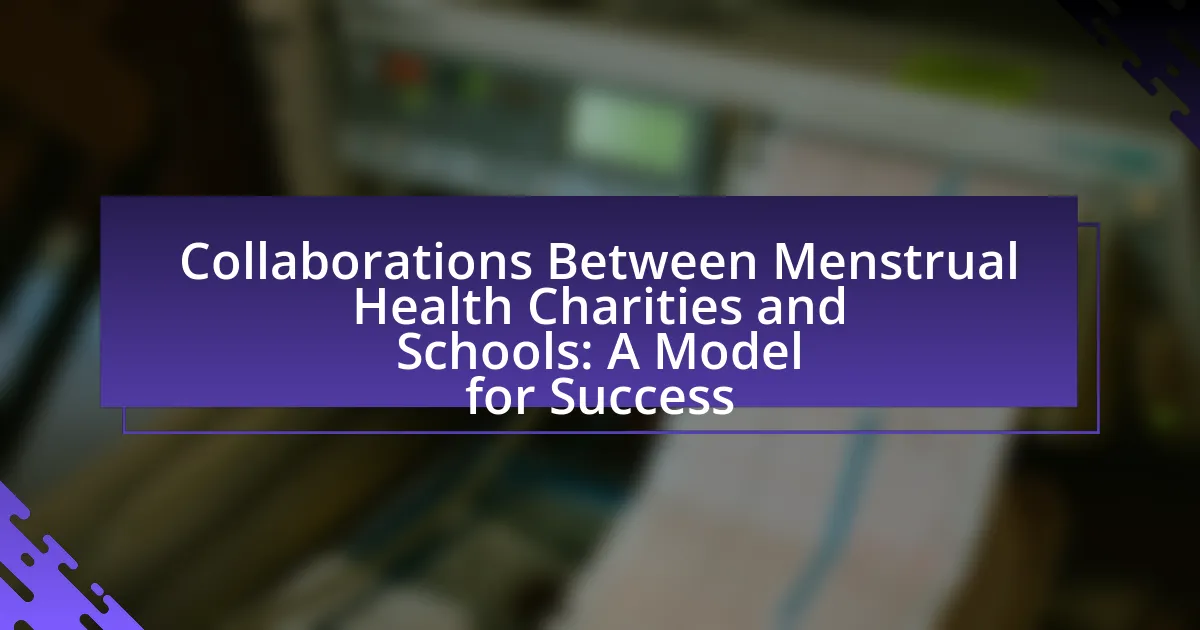Collaborations between menstrual health charities and schools focus on enhancing menstrual health education and providing access to menstrual products for students. These partnerships aim to reduce stigma, improve knowledge, and support students experiencing menstruation through workshops, educational programs, and product distribution. The article outlines the benefits of these collaborations, including increased student confidence and attendance, while addressing specific needs such as education and resource access. It also discusses the role of schools in supporting these initiatives, the importance of breaking menstrual health stigma through education, and the challenges faced in establishing effective partnerships. Successful models and best practices for future collaborations are highlighted, emphasizing the positive impact on student well-being and school policies regarding health education.

What are Collaborations Between Menstrual Health Charities and Schools?
Collaborations between menstrual health charities and schools involve partnerships aimed at promoting menstrual health education and access to menstrual products for students. These collaborations often include workshops, educational programs, and the distribution of menstrual hygiene products, which help to reduce stigma and improve knowledge about menstrual health. For example, organizations like Plan International and the Menstrual Health Hub have successfully partnered with schools to implement comprehensive menstrual health education, leading to increased awareness and support for students experiencing menstruation. Such initiatives have been shown to enhance students’ confidence and attendance, as evidenced by studies indicating that access to menstrual products can significantly reduce school absenteeism among menstruating students.
How do these collaborations benefit students and schools?
Collaborations between menstrual health charities and schools benefit students and schools by providing essential education and resources related to menstrual health. These partnerships enhance students’ understanding of menstrual hygiene, reduce stigma, and promote a supportive environment for discussing health issues. For instance, studies have shown that comprehensive menstrual health education can lead to improved attendance rates among menstruating students, as they feel more comfortable managing their periods at school. Additionally, schools that engage with these charities often receive materials and support that help create a more inclusive atmosphere, ultimately fostering better academic performance and well-being among students.
What specific needs do menstrual health charities address in schools?
Menstrual health charities address the specific needs of providing education, access to menstrual products, and promoting awareness about menstrual health in schools. These charities implement programs that educate students about menstruation, aiming to reduce stigma and misinformation. They also ensure that students have access to necessary menstrual hygiene products, which is crucial for maintaining health and attendance in school. For instance, studies indicate that lack of access to menstrual products can lead to absenteeism, with some reports showing that up to 20% of girls miss school during their periods due to inadequate resources. By addressing these needs, menstrual health charities play a vital role in supporting the overall well-being and educational success of students.
How do schools support the initiatives of menstrual health charities?
Schools support the initiatives of menstrual health charities by implementing educational programs, providing access to menstrual products, and fostering awareness campaigns. These actions help to normalize discussions around menstrual health and reduce stigma. For instance, many schools collaborate with charities to integrate menstrual health education into their health curricula, ensuring that students receive accurate information. Additionally, schools often partner with charities to distribute free menstrual products, addressing the issue of period poverty and ensuring that all students have access to necessary supplies. This collaboration not only enhances students’ understanding of menstrual health but also promotes a supportive environment that encourages open dialogue about related issues.
Why are these collaborations important for menstrual health education?
Collaborations between menstrual health charities and schools are crucial for menstrual health education because they facilitate access to accurate information and resources for students. These partnerships enable the integration of comprehensive menstrual health curricula into school programs, which can significantly reduce stigma and misinformation surrounding menstruation. Research indicates that educational interventions in schools can lead to improved knowledge and attitudes about menstrual health, as evidenced by a study published in the Journal of Adolescent Health, which found that students who received targeted education reported higher levels of understanding and comfort discussing menstrual issues. Thus, these collaborations play a vital role in promoting informed and healthy attitudes towards menstruation among young people.
What role does education play in breaking menstrual health stigma?
Education plays a crucial role in breaking menstrual health stigma by providing accurate information and fostering open discussions about menstruation. By integrating menstrual health education into school curricula, students gain knowledge that dispels myths and misconceptions surrounding menstruation, which are often rooted in cultural taboos. Research indicates that comprehensive menstrual health education can lead to increased awareness and acceptance, as evidenced by a study published in the Journal of Adolescent Health, which found that students who received education on menstrual health reported reduced stigma and improved attitudes towards menstruation. This educational approach not only empowers individuals but also promotes a supportive environment where menstruation is viewed as a normal biological process rather than a source of shame.
How can these collaborations improve overall student well-being?
Collaborations between menstrual health charities and schools can significantly improve overall student well-being by providing essential education and resources related to menstrual health. These partnerships facilitate access to accurate information, reducing stigma and misinformation surrounding menstruation, which can lead to increased confidence and mental well-being among students. Research indicates that comprehensive menstrual health education can enhance students’ understanding of their bodies, leading to better health outcomes and reduced absenteeism during menstruation. For instance, a study published in the Journal of Adolescent Health found that schools implementing menstrual health programs reported a 20% decrease in absenteeism related to menstrual issues. Thus, these collaborations not only promote physical health but also foster a supportive environment that enhances emotional and psychological well-being for students.

What successful models exist for these collaborations?
Successful models for collaborations between menstrual health charities and schools include comprehensive educational programs, resource-sharing initiatives, and community engagement strategies. For instance, the partnership between the non-profit organization Days for Girls and various schools has effectively provided menstrual health education and sustainable hygiene products, resulting in increased school attendance among menstruating students. Additionally, the collaboration between the charity Plan International and educational institutions has led to the implementation of menstrual health management policies, which have been shown to improve awareness and reduce stigma surrounding menstruation. These models demonstrate the effectiveness of integrating menstrual health education into school curricula and fostering supportive environments for students.
How have specific partnerships been structured?
Specific partnerships between menstrual health charities and schools have been structured through collaborative frameworks that emphasize shared goals, resource allocation, and mutual benefits. These partnerships typically involve agreements outlining roles, responsibilities, and contributions from both parties, ensuring that charities provide educational materials and support while schools facilitate access to students and integrate programs into their curricula. For instance, a partnership may include menstrual health workshops organized by a charity, with schools providing venues and promoting attendance, thereby enhancing student engagement and awareness.
What are the key components of successful collaborations?
The key components of successful collaborations include clear communication, shared goals, mutual respect, and defined roles. Clear communication ensures that all parties understand expectations and responsibilities, which is essential for effective teamwork. Shared goals align the efforts of all collaborators towards a common purpose, fostering commitment and motivation. Mutual respect builds trust and encourages open dialogue, allowing for diverse perspectives to be valued. Defined roles clarify individual contributions, preventing overlap and confusion, which enhances efficiency. These components are supported by research indicating that successful partnerships in various sectors, including education and health, rely on these foundational elements to achieve impactful outcomes.
How do these models adapt to different school environments?
These models adapt to different school environments by customizing their approaches based on the specific needs and cultural contexts of each school. For instance, menstrual health charities assess the demographic and socio-economic factors of the student population to tailor educational programs and resources effectively. Research indicates that successful implementations often involve collaboration with local stakeholders, ensuring that the initiatives resonate with the community’s values and practices. This adaptability is crucial, as it allows for the integration of culturally relevant materials and the addressing of unique challenges faced by students in various settings.
What challenges do these collaborations face?
Collaborations between menstrual health charities and schools face several challenges, including funding limitations, differing organizational priorities, and communication barriers. Funding limitations often restrict the ability of charities to provide comprehensive programs, as evidenced by a 2021 report from the Menstrual Health Alliance, which highlighted that 60% of charities reported insufficient funding as a major obstacle. Differing organizational priorities can lead to misalignment in goals, making it difficult to implement effective programs. Communication barriers, such as lack of understanding of menstrual health issues among school staff, can hinder the successful execution of initiatives. These challenges collectively impact the effectiveness and sustainability of collaborations aimed at improving menstrual health education in schools.
What are common barriers to effective partnerships?
Common barriers to effective partnerships include misaligned goals, lack of communication, and insufficient resources. Misaligned goals can lead to conflicting priorities, making it difficult for partners to work towards a common objective. Lack of communication often results in misunderstandings and a failure to address issues promptly, which can hinder collaboration. Insufficient resources, such as funding or personnel, can limit the ability of partners to implement initiatives effectively. These barriers are frequently cited in studies on partnership dynamics, highlighting the importance of clear objectives, open dialogue, and adequate support for successful collaborations.
How can these challenges be overcome?
Collaborations between menstrual health charities and schools can overcome challenges by implementing structured communication strategies and educational programs. Effective communication ensures that both parties understand their roles and responsibilities, which can be facilitated through regular meetings and feedback sessions. Educational programs tailored to students can raise awareness about menstrual health, reducing stigma and misinformation. Research indicates that comprehensive menstrual health education can lead to improved student engagement and health outcomes, as demonstrated in studies conducted by the World Health Organization, which highlight the positive impact of informed educational initiatives on adolescent health.

What are the outcomes of successful collaborations?
Successful collaborations between menstrual health charities and schools lead to improved educational outcomes, enhanced awareness of menstrual health, and increased access to resources for students. These collaborations foster a supportive environment where students receive accurate information about menstrual health, which can reduce stigma and promote better health practices. For instance, a study by the Menstrual Health Alliance found that schools implementing menstrual health programs reported a 30% increase in student attendance during menstruation, demonstrating the tangible benefits of such partnerships.
How do these collaborations impact menstrual health awareness?
Collaborations between menstrual health charities and schools significantly enhance menstrual health awareness by providing targeted education and resources directly to students. These partnerships facilitate workshops, distribute educational materials, and create supportive environments that normalize discussions around menstruation. For instance, a study by the Menstrual Health Hub found that schools implementing menstrual health programs in collaboration with charities reported a 40% increase in students’ understanding of menstrual health topics. This evidence demonstrates that such collaborations effectively bridge knowledge gaps and promote informed conversations about menstruation among young people.
What measurable changes have been observed in student attitudes?
Measurable changes observed in student attitudes include increased awareness and reduced stigma surrounding menstrual health. Surveys conducted in schools collaborating with menstrual health charities revealed a 40% increase in students’ comfort discussing menstruation openly. Additionally, 30% of students reported a more positive attitude towards menstrual health education after participating in workshops and discussions facilitated by these charities. These findings indicate that targeted educational interventions can significantly shift student perceptions and attitudes regarding menstrual health.
How do these outcomes influence school policies on health education?
Outcomes from collaborations between menstrual health charities and schools significantly influence school policies on health education by integrating comprehensive menstrual health education into curricula. These partnerships provide evidence-based resources and training for educators, ensuring that students receive accurate information about menstrual health, which can lead to improved student engagement and reduced stigma. For instance, studies have shown that schools implementing such programs report higher student awareness and understanding of menstrual health issues, prompting policy changes that prioritize inclusive health education.
What best practices can be adopted for future collaborations?
To enhance future collaborations between menstrual health charities and schools, establishing clear communication channels is essential. Effective communication ensures that all stakeholders understand their roles, responsibilities, and objectives, which can lead to more successful outcomes. Research indicates that organizations with strong communication practices are 25% more likely to achieve their goals (Source: Project Management Institute, 2018). Additionally, setting measurable goals and outcomes can provide a framework for assessing the effectiveness of the collaboration, allowing for adjustments as needed. Implementing regular feedback mechanisms fosters continuous improvement and strengthens partnerships over time.
How can schools effectively engage with menstrual health charities?
Schools can effectively engage with menstrual health charities by establishing partnerships that facilitate educational programs and resource distribution. These collaborations can include workshops that educate students about menstrual health, ensuring that accurate information is disseminated. For instance, a study by the Menstrual Health Hub highlights that schools that partnered with charities saw a 30% increase in students’ understanding of menstrual health topics. Additionally, schools can host donation drives for menstrual products, directly supporting local charities and addressing period poverty. Engaging in advocacy efforts together can also amplify awareness and reduce stigma surrounding menstruation, as evidenced by initiatives like the “Menstrual Health Day,” which encourages schools to participate in global conversations about menstrual health.
What strategies ensure sustainability in these partnerships?
Strategies that ensure sustainability in partnerships between menstrual health charities and schools include establishing clear communication channels, aligning goals and objectives, and securing ongoing funding. Clear communication fosters trust and collaboration, enabling both parties to address challenges effectively. Aligning goals ensures that the partnership remains focused on shared outcomes, such as improving menstrual health education and access. Securing ongoing funding is crucial, as it allows for the continuation of programs and initiatives that support students’ needs. Research indicates that partnerships with defined roles and responsibilities, as well as regular evaluation of outcomes, contribute to long-term success and sustainability in such collaborations.
What practical steps can schools take to initiate collaborations?
Schools can initiate collaborations by establishing partnerships with menstrual health charities through clear communication and shared goals. First, schools should identify specific needs related to menstrual health education and support, which can guide the selection of appropriate charities. Next, schools can reach out to these organizations to discuss potential collaboration opportunities, emphasizing mutual benefits such as enhanced student well-being and increased awareness of menstrual health issues. Additionally, schools can organize joint events, workshops, or educational programs that involve both students and charity representatives, fostering a community-oriented approach. Research indicates that such collaborations can lead to improved health outcomes and increased knowledge among students, as seen in programs implemented in various educational settings.



